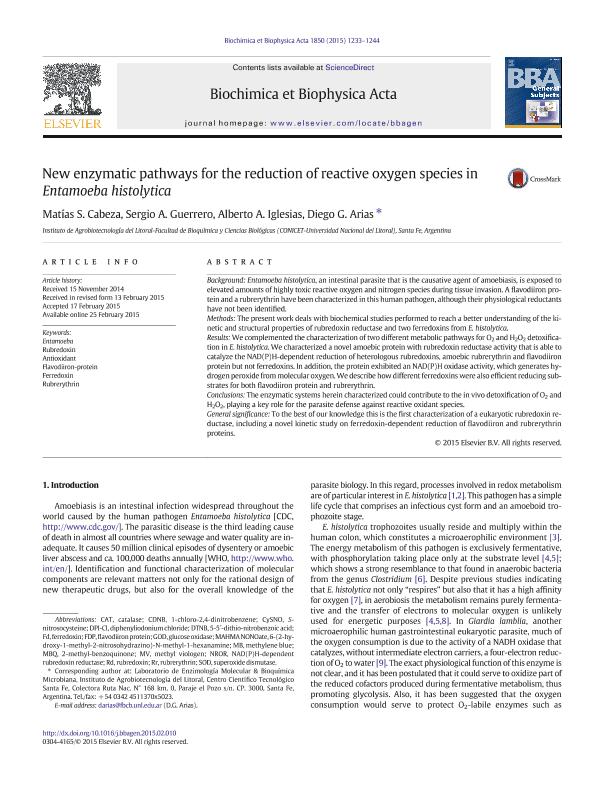Artículo
New enzymatic pathways for the reduction of reactive oxygen species in Entamoeba histolytica
Cabeza, Matías Sebastián ; Guerrero, Sergio Adrian
; Guerrero, Sergio Adrian ; Iglesias, Alberto Alvaro
; Iglesias, Alberto Alvaro ; Arias, Diego Gustavo
; Arias, Diego Gustavo
 ; Guerrero, Sergio Adrian
; Guerrero, Sergio Adrian ; Iglesias, Alberto Alvaro
; Iglesias, Alberto Alvaro ; Arias, Diego Gustavo
; Arias, Diego Gustavo
Fecha de publicación:
06/2015
Editorial:
Elsevier Science
Revista:
Biochimica et Biophysica Acta- General Subjects
ISSN:
0304-4165
Idioma:
Inglés
Tipo de recurso:
Artículo publicado
Clasificación temática:
Resumen
Background Entamoeba histolytica, an intestinal parasite that is the causative agent of amoebiasis, is exposed to elevated amounts of highly toxic reactive oxygen and nitrogen species during tissue invasion. A flavodiiron protein and a rubrerythrin have been characterized in this human pathogen, although their physiological reductants have not been identified. Methods The present work deals with biochemical studies performed to reach a better understanding of the kinetic and structural properties of rubredoxin reductase and two ferredoxins from E. histolytica. Results We complemented the characterization of two different metabolic pathways for O2 and H2O2 detoxification in E. histolytica. We characterized a novel amoebic protein with rubredoxin reductase activity that is able to catalyze the NAD(P)H-dependent reduction of heterologous rubredoxins, amoebic rubrerythrin and flavodiiron protein but not ferredoxins. In addition, the protein exhibited an NAD(P)H oxidase activity, which generates hydrogen peroxide from molecular oxygen. We describe how different ferredoxins were also efficient reducing substrates for both flavodiiron protein and rubrerythrin. Conclusions The enzymatic systems herein characterized could contribute to the in vivo detoxification of O2 and H2O2, playing a key role for the parasite defense against reactive oxidant species. General significance To the best of our knowledge this is the first characterization of a eukaryotic rubredoxin reductase, including a novel kinetic study on ferredoxin-dependent reduction of flavodiiron and rubrerythrin proteins.
Palabras clave:
Antioxidant
,
Entamoeba
,
Ferredoxin
,
Flavodiiron-Protein
,
Rubredoxin
,
Rubrerythrin
Archivos asociados
Licencia
Identificadores
Colecciones
Articulos(IAL)
Articulos de INSTITUTO DE AGROBIOTECNOLOGIA DEL LITORAL
Articulos de INSTITUTO DE AGROBIOTECNOLOGIA DEL LITORAL
Citación
Cabeza, Matías Sebastián; Guerrero, Sergio Adrian; Iglesias, Alberto Alvaro; Arias, Diego Gustavo; New enzymatic pathways for the reduction of reactive oxygen species in Entamoeba histolytica; Elsevier Science; Biochimica et Biophysica Acta- General Subjects; 1850; 6; 6-2015; 1233-1244
Compartir
Altmétricas



